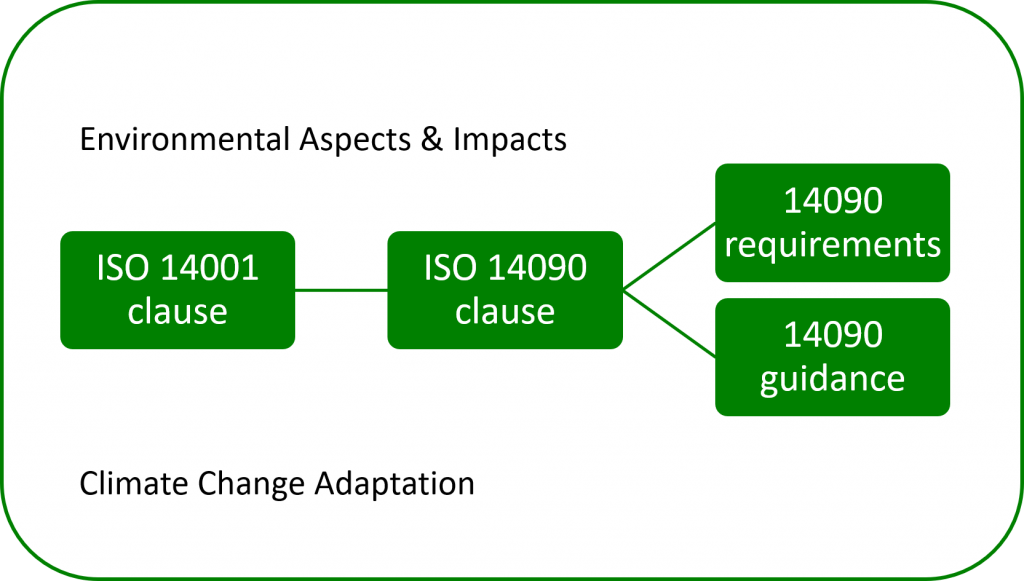ISO 14090 – 14001 White Paper
 As well as reducing carbon emissions, we should all be including climate adaptation in our EMS. I recently wrote an article for IEMA on a new white paper to help people do just that.
As well as reducing carbon emissions, we should all be including climate adaptation in our EMS. I recently wrote an article for IEMA on a new white paper to help people do just that.
In Perfect Alignment – Embedding Climate Adaptation into your EMS
A new white paper from ISO covers the ISO 14090 ‘Adaptation to climate change’ standard and helps users address these issues in their own Environmental Management Systems. Anya Ledwith and John Dora take a closer look.
IEMA members can’t help to be aware of the climate emergency and, in the run-up to COP26, it seems the wider world is taking notice as well.
Climate change is already affecting us with different weather patterns, more extreme weather events, sea-level rise, flooding, storm surges, drought and erosion. We are seeing biodiversity loss, poor air quality, effects on employee health and safety, disruptions to operations and value chains. This is triggering changes to the way we vote, we regulate, we live and we do business.
Countries, businesses, organisations and individual consumers are committing to Net Zero targets, to manage their carbon impact, set reduction targets and ultimately offset their unavoidable emissions.
While the focus of these Net Zero plans is to reduce carbon emissions, it is also important that organisations consider the issues of climate change adaptation.
With this in mind, experts from around the world collaborated to develop an international standard on the subject and, in 2019, published ISO 14090 Adaptation to climate change — Principles, requirements and guidelines.
ISO 14090 aims to help organisations assess climate change impacts and put plans in place for effective adaptation. It helps them identify and manage risks, as well as seize any opportunities that climate change may bring.
Given that climate change will continue over a very long period of time, ISO 14090 considers adaptation efforts over the short, medium and long term. Organisations need to assess the timescales of potential adaptation actions as well as their long-term consequences. The standard refers to indicators that help to measure how climate change is affecting the organisation and how it itself is evolving to those challenges.
ISO 14090 and ISO 14001 White Paper
How do organisations go about embedding climate adaptation into their processes? A good place to start will be their Environmental Management System. The EMS already provides a framework for identifying and managing environmental aspects, considering not only their own impacts, also how the external environment affects them. Thus, climate change issues are already key in many EMSs.
ISO 14001 is the most widely used standard for EMS, with over 300,000 certificates issued worldwide. It makes sense, therefore, to align the two standards. Indeed ISO 14090 has been written in a way that should make it relatively easy for users of ISO 14001 to adopt.
To help users get started, ISO has recently published a white paper showing the alignments between the two standards. Using this, ISO hopes that users of ISO 14001 can accelerate their adaptation to climate change and build resilience.
The white paper goes through the key clauses of ISO 14001, showing how ISO 14090 supports them and provides further assistance, all laid out in a helpful table.
For example, the ISO 14001 Clause 6 Planning requires the organisation to identify risks and opportunities, aspects, compliance obligations etc, and then establish objectives and plans to achieve them.
The white paper shows the relevant ISO 14090 clauses, as follows:
– Clause 6 Assessing climate change impacts including opportunities notes a requirement to assess the organisation’s climate change impacts and its capacity to adapt to these impacts.
– Clauses 7 Adaptation planning and 8.2 Implementation plan require the organisation to establish climate adaptation priorities, identify adaptation actions, develop an implementation plan and incorporate adaptation into its policies, strategies and plans.
ISO 14090 provides extensive guidance on impact assessment methods, plus identifying and evaluating potential actions (their suitability and potential impact) and developing the content and objectives of the adaptation plan. It notes how actions may be soft measures improving capacity to adapt (for example, embedding climate change into policies and operational procedures, training, and awareness raising) or hard measures (such as infrastructure/building design or flood protection zones).
Clearly climate adaptation is relevant in more areas of the EMS than this, as understanding climate impacts is not just for those implementing climate actions. Organisational decisions are made on the basis of risks and opportunities, so understanding resilience is useful across the value chain such as in purchasing, investment and insurance.
ISO 14090 in use
The authors have worked with a number of organisations that see benefits in using ISO 14090. Network Rail is the kind of organisation that takes its responsibilities seriously and understands how ISO 14090 is relevant to its preparations to address climate impacts. Network Rail has published ‘Weather Resilience and Climate Change Adaptation Plans’ for all its routes, outlining climate hazards, vulnerability assessments and measures to respond to these.
The National Trust is another good example and is actively using ISO 14090 for its adaptation and resilience building to address current and future climate impacts. ISO 14001 is already part of National Trust’s ‘toolkit’, so the linkages featured in the white paper give added strength and credibility to the Trust’s governance arrangements to address longer-term climate changes.
The diversity of interest across sectors is further demonstrated in Canada, by a Government of Canada department, which is keen to promote adaptation and is engaged in learning more about how ISO 14090 could be used throughout its diverse organisation.
Further Guidance
The ISO 14090 – 14001 white paper is available to download for free, from the ISO website.
In addition to this white paper, in 2018 IEMA also produced guidance ‘Driving Climate Actions through Environmental Management Systems’. This goes through ISO 14001 clause by clause, showing how each clause contributes to climate action, both mitigation and adaptation.
ISO 14090 is the first of a series of standards on climate adaptation, including ISO 14091 on impacts and risk assessment, also ISO 14092 adaptation planning for local governments and communities
Each of these publications is a very useful resource for any sustainability professional responsible for embedding climate change mitigation and adaptation into their organisation.
About the authors:
– Anya Ledwith FIEMA, Founder of Eshcon Ltd
– Prof John Dora, Director of Climate Sense and visiting professor at the University of Surrey
Both are members of ISO and BSI committees on Environmental Management System standards and managing greenhouse gases. John chaired the groups that drafted ISO 14090 and wrote the white paper.


